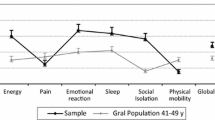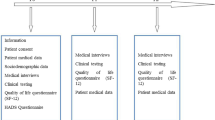Abstract
Aim
To analyse drug consumption patterns and demographic and medical factors associated with health-related quality of life (HRQL) in a nonclinical sample of regular cocaine consumers.
Methods
Face-to-face interviews with 687 young regular cocaine users (aged 18–30 years) in three Spanish cities: Barcelona, Madrid and Seville. HRQL was measured using the Nottingham Health Profile (NHP), and degree of dependence through the Severity of Dependence Scale (SDS). Bivariate analyses were conducted using nonparametric techniques, and a Tobit regression analysis was carried out to determine which variables best explained HRQL.
Results
Most participants showed a good HRQL, but differences in HRQL were found for sociodemographic (gender), medical (days stayed in bed during the previous 12 months) and consumption-pattern related variables (length of drug use, intravenous drug use, crack use, SDS). In multivariate analyses cocaine dependence measured by SDS explained the greatest amount of HRQL variation. Although women declared worse HRQL (13.6 versus 9.7, P < 0.01), in the final model with interactions no gender differences were observed, except that HRQL for women worsened with the number of days they had stayed in bed in the previous 12 months.
Conclusions
Even in early phases of dependence, deterioration in HRQL is observed, mainly related to drug-use history and patterns.


Similar content being viewed by others
References
European Monitoring Centre for Drug and Drug Addiction. (2005). Annual report 2005: The state of the drugs problems in Europe. Luxembourg: Office for Official Publications of the European Communities.
Observatorio Español sobre Drogas. (2007). Informe de la encuesta sobre uso de drogas en estudiantes de enseñanzas secundarias (ESTUDES) 2006–2007. Madrid: Ministerio Sanidad y Consumo.
European Monitoring Centre for Drug and Drug Addiction. (2007). Cocaine and crack cocaine: a growing public health issue. Luxembourg: Office for Official Publications of the European Communities.
Observatorio Español sobre Drogas. (2004). Informe 2004. Situación y tendencias de los problemas de drogas en España. Madrid: Ministerio Sanidad y Consumo.
Ghuran, A., & Nolan, J. (2000). Recreational drug misuse: Issues for the cardiologist. Heart (British Cardiac Society), 83, 627–633. doi:10.1136/heart.83.6.627.
Balcells, M. (2001). Complicaciones orgánicas de la cocaína. Adicciones, 13(suppl 2 Cocaína), 167–179.
Kpnuepfer, M. (2003). Cardiovascular disorders associated with cocaine use: Myths and truths. Pharmacology & Therapeutics, 97, 181–222. doi:10.1016/S0163-7258(02)00329-7.
Herrero, M. J., et al. (2008). Psychiatric comorbidity in young cocaine users: Induced vs. independent disorders. Addiction (Abingdon, England), 103, 284–293.
Rounsaville, B. J., et al. (1991). Psychiatric diagnoses of treatment-seeking cocaine abusers. Archives of General Psychiatry, 48(1), 43–51.
Torrens, M., et al. (1997). Use of the Nottingham Health Profile for measuring health status of patients in methadone maintenance treatment. Addiction (Abingdon, England), 92(6), 707–716. doi:10.1111/j.1360-0443.1997.tb02937.x.
Giacomuzzi, S. M., et al. (2005). Sublingual buprenorphine and methadone maintenance treatment: A three-year follow-up of quality of life assessment. The Scientific World Journal, 5, 452–468. doi:10.1100/tsw.2005.52.
Ryan, C., & White, J. (1996). Health status at entry to methadone maintenance treatment using the SF-36 health survey questionnaire. Addiction (Abingdon, England), 91(1), 39–45. doi:10.1111/j.1360-0443.1996.tb03160.x.
Millson, P., et al. (2004). Self-perceived health among Canadian opiate users. Canadian Journal of Public Health. Revue canadienne de santé publique, 95(2), 99–103.
Puigdollers, E., et al. (2004). Characteristics of heroin addicts entering methadone maintenance treatment: Quality of life and gender. Substance Use & Misuse, 39(9), 1353–1368. doi:10.1081/JA-120039392.
Millson, P., et al. (2006). Determinants of health-related quality of life opiate users at entry to low-threshold methadone programs. European Addiction Research, 12, 74–82. doi:10.1159/000090426.
Nunes, EV. (1997). Methodologic recommendations for cocaine abuse clinical trials: a clinician-researcher's perspective. NIDA Research Monograph, 175, 73–95.
Moras, K. (1997). Outcome measurement considerations: pharmacological treatments for substance abuse. NIDA Research Monograph, 175, 118–136.
Falck, R., et al. (2000). Crack-cocaine use and health status as defined by the SF-36. Addictive Behaviors, 25(4), 579–584. doi:10.1016/S0306-4603(99)00040-4.
Falck, R. S., et al. (2000). Longitudinal application of the medical outcomes study 36-item short-form health survey with not-in-treatment crack-cocaine users. Medical Care, 38(9), 902–910. doi:10.1097/00005650-200009000-00004.
Chen, K., et al. (1996). Effects of chronic cocaine use on physical health: A prospective study in a general population sample. Drug and Alcohol Dependence, 43, 23–37. doi:10.1016/S0376-8716(96)01285-9.
González-Saiz, F., & Carulla, S. (1998). Estudio de fiabilidad y validez de la versión española de la escala severity of dependence scale (SDS). Adicciones, 10(3), 223–232.
Gossop, M., et al. (1995). The Severity of Dependence Scale (SDS): psychometric properties of the SDS in English and Australian samples of heroin, cocaine and amphetamine users. Addiction (Abingdon, England), 90, 607–614. doi:10.1111/j.1360-0443.1995.tb02199.x.
Alonso, J., et al. (1990). Spanish version of the Nottingham Health Profile: Translation and preliminary validity. American Journal of Public Health, 80(6), 704–708.
Alonso, J., et al. (1994). The Spanish version of the Nottingham Health Profile: A review of adaptation and instrument characteristics. Quality of Life Research: An International Journal of Quality of Life Aspects of Treatment Care and Rehabilitation, 3(6), 385–393.
Tobin, J. (1958). Estimation of relationships for limited dependent variables. Econometrica, 26, 24–36. doi:10.2307/1907382.
Bleda, M. J., & Tobías, A. (2002). Aplicación de los modelos de regresión tobit en la modelización de variables epidemiológicas censuradas. Gaceta Sanitaria, 16(2), 188–195.
Arostegui, I., et al. (2007). Analysis of the short form-36 (SF-36): The beta-binomial distribution approach. Statistics in Medicine, 26, 1318–1342. doi:10.1002/sim.2612.
O’Brien, S., et al. (2006). Maintenance pharmacotherapy for opioid dependence and SF-36 health status: A comparison with general population norms and other chronic disorders. Addictive Disorders & Their Treatment, 5(4), 155–164. doi:10.1097/01.adt.0000210078.99735.27.
Neale, J. (2004). Measuring the health of Scottish drug users. Health & Social Care in the Community, 12(3), 202–211. doi:10.1111/j.1365-2524.2004.00489.x.
Morgan, M. Y., et al. (2004). Improvement in quality of life after treatment for alcohol dependence with acamprosate and psychosocial support. Alcoholism, Clinical and Experimental Research, 28(1), 64–67. doi:10.1097/01.ALC.0000108652.73143.4B.
Boys, A., et al. (2001). Understanding reasons for drug use amongst young people: A functional perspective. Health Education Research Theory and Practice, 16(4), 457–469.
Kaye, S., & Darke, S. (2002). Determining a diagnostic cut-off on the Severity of Dependence Scale (SDS) for cocaine dependence. Addiction (Abingdon, England), 97(6), 727–731. doi:10.1046/j.1360-0443.2002.00121.x.
Foster, J. H., et al. (2000). Quality of life measures and outcome in alcohol-dependent men and women. Alcohol (Fayetteville, N.Y.), 22(1), 45–52. doi:10.1016/S0741-8329(00)00102-6.
Domingo-Salvany, A., et al. (2003). Health related quality of life in young drug users. Quality of Life Research: An International Journal of Quality of Life Aspects of Treatment, Care and Rehabilitation, 12, 843.
Stein, M. D., et al. (1998). The functioning and well being of persons who seek treatment for drug and alcohol use. Journal of Substance Abuse, 10, 75–84. doi:10.1016/S0899-3289(99)80142-4.
Garg, N., et al. (1999). Effect of gender, treatment site and psychiatric comorbidity on quality of life outcome in substance dependence. The American Journal on Addictions/American Academy of Psychiatrists in Alcoholism and Addictions, 8, 44–54.
Linzer, M., et al. (1996). Gender, quality of life, and mental disorders in primary care: Results from the PRIME-MD 1000 study. The American Journal of Medicine, 101(5), 526–533. doi:10.1016/S0002-9343(96)00275-6.
Robb, J. C., et al. (1998). Gender differences in patients with bipolar disorder influence outcome in the medical outcomes survey (SF-20) subscale scores. Journal of Affective Disorders, 49(3), 189–193. doi:10.1016/S0165-0327(98)00003-2.
Westbrook, J., et al. (2002). Gender differences in the symptoms and physical and mental well-being of dyspeptics: A population based study. Quality of Life Research: An International Journal of Quality of Life Aspects of Treatment Care and Rehabilitation, 11(3), 283–291.
Acknowledgements
The study was financed by the Fundación para Investigación y la Prevención del Sida en España (FIPSE 36253/01), the analyses by FIS-Redes de investigación cooperativa RTICS: C03-09 (RCESP) and G03 03-005 (RTA) and administrative support by CIRIT 22001SGR00405.
Author information
Authors and Affiliations
Consortia
Corresponding author
Additional information
ITINERE Investigators include: Rosario Ballesta Gomez, Gregorio Barrio, Francisco González-Saiz, M José Bravo Portela, Dani Lacasa, David Fernández, Sofia Ruiz Curado, Fermin Fernández Calderón, Teresa Silva, Luis Royuela, Fernando Vallejo, Montserrat Neira, and José Pulido.
Rights and permissions
About this article
Cite this article
Lozano, O.M., Domingo-Salvany, A., Martinez-Alonso, M. et al. Health-related quality of life in young cocaine users and associated factors. Qual Life Res 17, 977–985 (2008). https://doi.org/10.1007/s11136-008-9376-8
Received:
Accepted:
Published:
Issue Date:
DOI: https://doi.org/10.1007/s11136-008-9376-8




